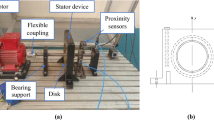Abstract
Blade vibration failure is one of the main failure modes of compressor wheel of turbocharger for vehicle application. The existing models for evaluating the reliability of blade vibration of compressor wheel are static, and can not reflect the relationship between the reliability of compressor wheel with blade vibration failure mode and the life parameter. For the blade vibration failure mode of compressor wheel of turbocharger, the reliability evaluation method is studied. Taking a compressor wheel of turbocharger for vehicle application as an example, the blade vibration characteristics and how they change with the operating parameters of turbocharger are analyzed. The failure criterion for blade vibration mode of compressor wheel is built with the Campbell diagram, and taking the effect of the dispersity of blade natural vibration frequency and randomness of turbocharger operating speed into account, time-dependent reliability models of compressor wheel with blade vibration failure mode are derived, which embody the parameters of blade natural vibration frequency, turbocharger operating speed, the blade number of compressor wheel, life index and minimum number of resonance, etc. Finally, the rule governing the reliability and failure rate of compressor wheel and the method for determining the reliable life of compressor with blade vibration is presented. A method is proposed to evaluate the reliability of compressor wheel with blade vibration failure mode time-dependently.
Similar content being viewed by others
References
ZHU D X. Turbocharging and turbocharger[M]. Beijing: China Machine Press, 1992. (in Chinese)
STEPHAN M S, MARTIN S, OTTMAR S. Blade excitation in pulse-charged mixed-flow turbocharger turbines[J]. Journal of Turbomachinery, 2011, 133: 0210121–0210126.
PIERRE B, REGIS L. Nonintrusive turbomachine blade vibration measurement system[J]. Mechanical Systems and Signal Processing, 2007, 21: 1 717–1 738.
PANKAJ K, NARAYANAN S. Nonlinear stochastic dynamics, chaos, and reliability analysis for a single degree of freedom model of a rotor blade[J]. Journal of Engineering for Gas Turbines and Power, 2009, 131: 0125061–0125067.
LIN H Y, CHEN M. Analysis of stress and vibration of blade for aero turbocharger[J]. Noise and Vibration Control, 2009, 6: 44–49. (in Chinese)
TSAI J I. Design of a short-time compensation capacitor for turbine blade vibration suppression[J]. Electric Power Systems Research, 2007, 77: 1 619–1 626.
HONG H Y, JUNG H P, JANGHYUN P. Vibration analysis of rotating pre-twisted blades[J]. Computers and Structures, 2001, 79:1 811–1 819.
MA Y X, LI H B, WANG Y D, et al. Blade vibration analysis of turbocharger turbine[J]. Journal of Vibration, Measurement & Diagnosis, 2005, 25(2): 131–133. (in Chinese)
TSAI G C. Rotating vibration behavior of the turbine blades with different groups of blades[J]. Journal of Sound and Vibration, 2004, 271: 547–575.
ZHU B S, KAMEMOTO K, CAO S L. Investigation on probability of self-oscillation induced by vortex shedding from a thin cambered blade[J]. Chinese Journal of Mechanical Engineering, 2006, 42(1): 35–39. (in Chinese)
LIN J W, ZHANG J H, ZHANG G H, et al. Aero-engine blade fatigue analysis based on nonlinear continuum damage model using neural networks[J]. Chinese Journal of Mechanical Engineering, 2012, 25(2): 338–345.
WANG Z, XIE L Y. Dynamic reliability model of components under random load[J]. IEEE Transactions on Reliability, 2008, 57(3): 474–479.
WANG Z. Method for calculating failure rate of components and systems based on load-strength interference[D]. Beijing: Beijing University of Aeronautics and Astronautics, 2010. (in Chinese)
Author information
Authors and Affiliations
Corresponding author
Additional information
This project is supported by National Natural Science Foundation of China (Grant Nos. 51375465, 50905007)
WANG Zheng, born in 1981, is currently an associate research fellow at Science and Technology on Diesel Engine Turbocharging Laboratory, China North Engine Research Institute, China. He received his bachelor degree from Shenyang Institute of Technology, China, and his PhD degree from Northeastern University, China, in 2003, and 2008, respectively. His research interests include mechanical system reliability, engine turbocharging, and structural fatigue.
WANG Zengquan, born in 1962, is currently a researcher at China North Engine Research Institute, China, and the chief expert of China North Industries Group Corporation, China. He received his bachelor degree and master degree from Beijing Institute of Technology, China, in 1982, and 2001, respectively. His research interests include special vehicle engine design, diesel engine reliability and engine turbocharging technology.
ZHUANG Li, born in 1982, is currently an engineer at Science and Technology on Diesel Engine Turbocharging Laboratory, China North Engine Research Institute, China. She received her bachelor degree from Inner Mongolia University of Technology, China, in 2006. Her research interests include engine turbocharging technology and turbocharging system reliability.
WANG A-na, born in 1986, is currently a research assistant at Center of Engine Test and Measurement, China North Engine Research Institute, China. She received her bachelor degree and master degree from Shenyang Institute of Technology, China, in 2008, and 2011, respectively. Her research interests include engine test and reliability analysis.
Rights and permissions
About this article
Cite this article
Wang, Z., Wang, Z., Zhuang, L. et al. Time-dependent vibration frequency reliability analysis of blade vibration of compressor wheel of turbocharger for vehicle application. Chin. J. Mech. Eng. 27, 205–210 (2014). https://doi.org/10.3901/CJME.2014.01.205
Received:
Revised:
Accepted:
Published:
Issue Date:
DOI: https://doi.org/10.3901/CJME.2014.01.205




